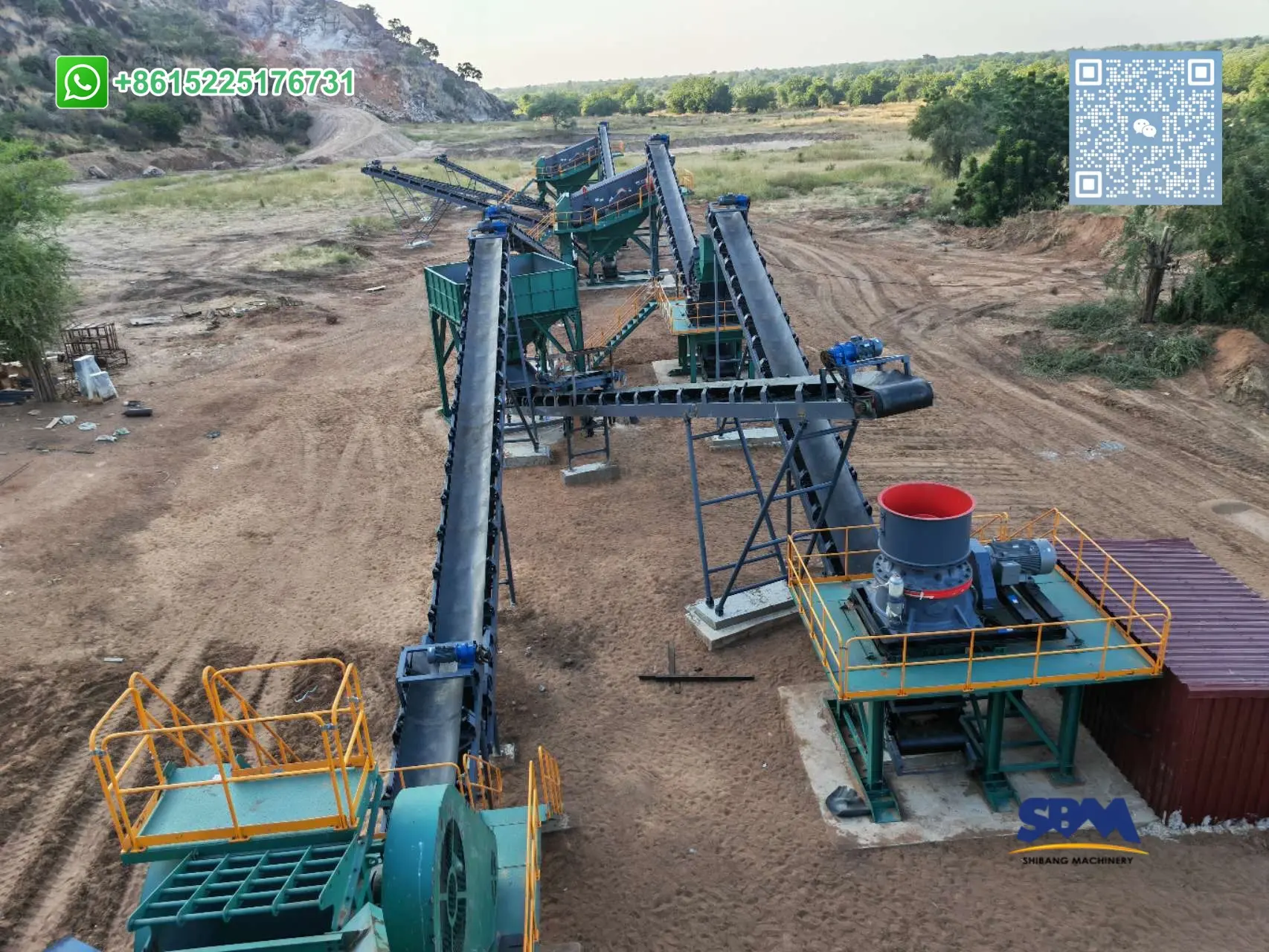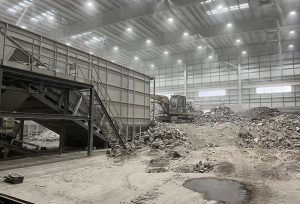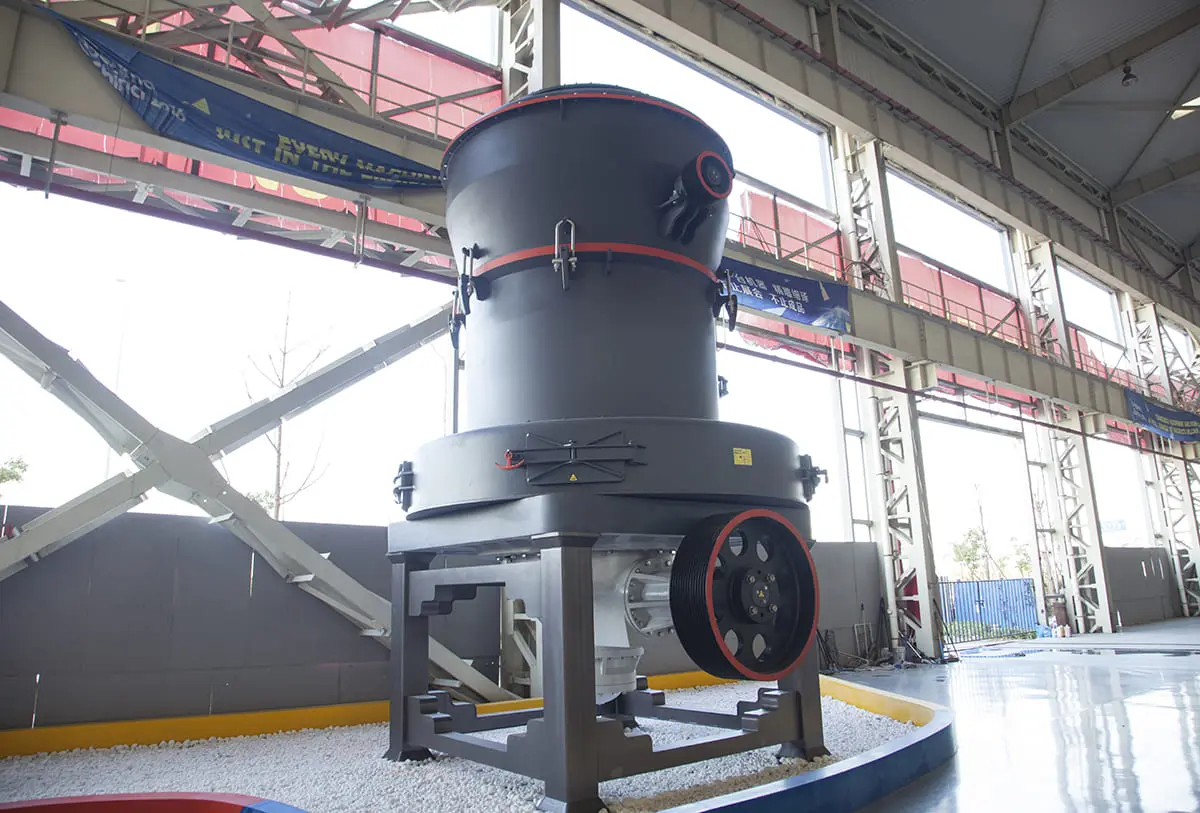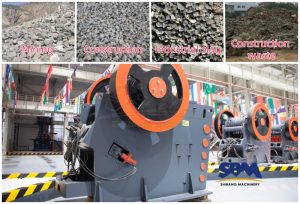Correo electrónico: [email protected]
Procesamiento de calcita: Guía de equipos y aplicaciones
La calcita está en todas partes, Incluso si no te das cuenta. That stunning mármol countertop? Es principalmente calcita. El papel suave en su impresora? El polvo de calcita juega un papel, también. The white lines on the road? Sí, that’s usually calcite, también. This mineral, calcium carbonate (Caco₃) in its purest form, isn’t just geologically fascinating for its endless array of crystal forms; it’s also a workhorse. Industries from construction and papermaking to paints and plastics rely on processed calcite. But how does a chunk of calcita from a quarry become the fine powder in paint or the perfect sand in concrete? no es magico; it’s a fascinating, tenacious, and highly engineered process of calcite processing, aplastante, sandmaking, y molienda. Let’s pull back the curtain.
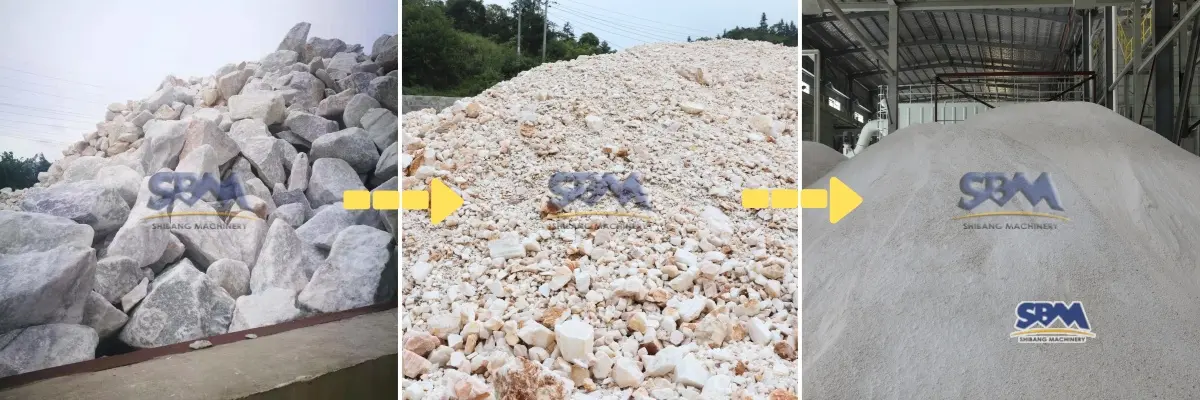
Why Calcite Behaves the Way It Does (And Why It Matters)
What was the first thing you learned about calcite processing? It’s trickily soft. That hardness level of 3 sounds simple – and it’s easier than granito. Pero aquí está la captura: it breaks perfectly. Hit it correctly, and it splits neatly into little squares. Hit it poorly or use bad equipment, and you get messy dust mixed with large pieces. This easy-breaking nature is both good and bad. It makes crushing use less power than for harder rocks, but you really must pick the proper crusher and grinder. Mess this up, and you burn extra energy, ruin machines faster, and get material that might fail quality checks.
También, since it’s calcium carbonate (Caco₃), it changes when touching acids. This helps in uses like helping soil but causes big problems if acid water touches your stored fine powder. Knowing these key points isn’t just theory—it’s essential for building a calcite line that works well and makes money.
Escenario 1: Breaking It Down – The Crushing Game For Calcite Processing
Before you make sand or powder, you need smaller rocks. Crushing is the unavoidable, often noisy, first act in the calcite processing play. Meta? Reduce those massive quarry blocks into pieces small enough for the next stage (sand making or grinding), efficiently and controllably.
1.1 Walking Through the Crushing Line (Paso a paso):
Imagine the rock arriving. Big, irregular chunks, maybe up to a meter across. Here’s what happens:
- The Big Squeeze (Trituración Primaria): Those large blocks (<400mm is typical feed size) get dumped onto a alimentador vibrante. This feeder is crucial – it meters the rock steadily into the gaping mouth of the rompe mandíbulas. Think of massive, rugged steel plates. One’s fixed, the other moves in a chewing motion. The rock gets caught and crushed. Out comes material typically around 100-150mm. It’s coarse, angular, and ready for the next round. The feeder’s rhythm is vital; overload the jaw, and it chokes. Underload it, and you waste capacity.
- Refining the Crush (Trituración Secundaria): The coarse output from the jaw isn’t the end. It gets carried away on a conveyor belt – a surprisingly critical component prone to wear and tear from the abrasive rock. This material feeds either an trituradora de impacto o un trituradora de cono. The impact crusher hurls the rock against hard surfaces or other rocks at high speed, smashing it further. The cone crusher squeezes rock between an outer bowl and a gyrating inner cone. This stage aims for pieces between about 5mm and 50mm. The choice here significantly impacts the forma of the final crushed product.
- Sorting It Out (Poner en pantalla): Not everything coming out of the secondary crusher is the right size. Multas (polvo) and oversized chunks sneak through. Entonces, the crushed mix hits a pantalla vibratoria. Think of a giant, multi-deck sieve shaking vigorously. Different screen mesh sizes separate the flow into distinct piles: maybe 0-5mm (often feed for sand making or fines for some grinding), 5-20milímetro (popular aggregate size), and 20-50mm (another aggregate fraction). Oversize? It gets looped back to the secondary crusher for another go (circuito cerrado). This step is all about precision and efficiency – getting the right sizes where they need to be.
1.2 Picking Your Crusher: It’s Not One-Size-Fits-All
You wouldn’t use a sledgehammer to crack a walnut, right? Same with calcite processing crushers. Each type has its sweet spot. Compañías como SBM China offer robust options, but knowing which one suits your needs is key.
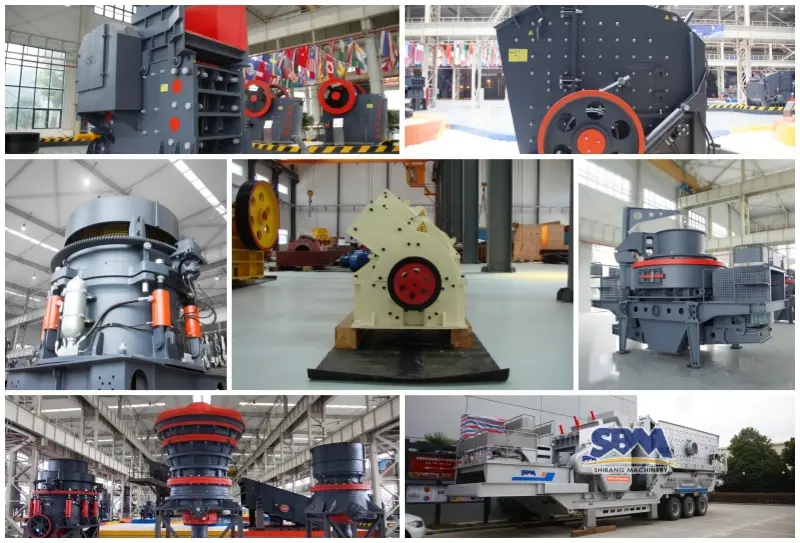
1.2.1 El Rompe mandíbulas: The Primary Powerhouse
- Where it Shines: First in line. It handles the big, nasty chunks straight from the quarry face. Nothing else really does this initial size reduction as reliably for the cost. The mechanics are simple and tough. Mantenimiento, while frequent due to wear on the jaw plates, is generally straightforward for a decent mechanic. Operating costs per ton are usually low.
- The Reality Check: Es loud. Ear protection is mandatory. And those jaw plates? They wear out, constantly. You need a good inventory and a sharp maintenance team. The output shape is pretty angular – fine for base layers but not ideal if you need cube-shaped aggregate for high-strength concrete. Feed size variation can cause hiccups.
- Bottom Line: Your indispensable first step for big rock. Rugged, cost-effective for primary duty, but noisy and hungry for wear parts. The foundation of most calcite processing lines.
1.2.2 El Trituradora de cono: The Shape Master (Secundario)
- Where it Shines: This machine is your best bet después the jaw crusher when you need uniform, piezas de forma cuadrada (around 5-50mm). It crushes rocks between its moving parts in a way that makes much better-shaped stones than a jaw crusher – super important for concrete where rocks need to fit together tightly. It’s also much better sealed up than jaw or impact crushers, meaning way less dust gets out (great for workers’ lungs and passing inspections). Plus, it’s generally quieter than other crushers.
- The Reality Check: It’s a more complicated machine than a jaw crusher. More parts move, and it needs precise setup. Getting the gap size (called CSS) right is crucial for the stone size you want. The main crushing surfaces wear down, and changing them is a bigger job than replacing jaw plates. It costs more upfront. It really doesn’t like flat stones (“slabby rock”) or hidden metal pieces (“trampa”) – these can wreck parts fast and cost a lot. Tú must have good control over what’s fed into it from the first crusher.
- Bottom Line: Pick this for making high-quality building stones after the first crushing step. It gives excellent shape and controls dust well, but it’s more complex and costly. It demands careful running and careful feeding.
1.2.3 El trituradora de impacto: The Versatile Bruiser
- Where it Shines: Flexibilidad. It can handle primary crushing of smaller feed (if your quarry feed allows) o aplastante secundario. It often produces a better particle shape than a jaw (though maybe not quite as consistently cubical as a well-set cone). A huge advantage? You can often adjust the gap between the blow bars (martillo) and the impact aprons/curtains while running, changing the product size relatively easily. Great for brittle materials like calcite.
- The Reality Check: Tener puesto. Oh, the wear. Blow bars and impact aprons take a beating, especially with abrasive feed. Replacement costs can be significant and frequent. Dust generation is usually higher than a cone crusher – you voluntad need a good dust suppression or collection system (aerosoles de agua, baghouses). Noise levels are high, similar to jaw crushers. The product size distribution can sometimes be wider than desired.
- Bottom Line: Great versatility and adjustability. Good for situations where feed size varies or you need to switch product specs easily. But be prepared for higher wear costs and dust challenges. A solid choice for secondary crushing when shape matters but cone complexity/cost is prohibitive, or for primary on smaller-scale operations.
Crushing Equipment Face-Off: What Works Where
| Característica | Rompe mandíbulas | Trituradora de cono | trituradora de impacto | Real-World Implication |
|---|---|---|---|---|
| Primary Job | Smash Big Rocks First | Make Nice Cubes Later | Crush Now, Adjust Later | Defines its position in the line |
| Particle Shape | Bruto & Angular | Limpio & Cúbico | Pretty Good, Often Cubical | Critical for aggregate value |
| Piezas de desgaste | Placas de mandíbula (Wear Fast) | Mantle/Concave (Steady Wear) | Blow Bars/Aprons (Wear VERY Fast) | Major cost driver & downtime cause |
| Control de polvo | Bueno, Needs Help | Bien (Sealed Up) | Messy, Needs Serious Help | Ambiental & health compliance |
| Nivel de ruido | Deafening | Bearable | Very Loud | Worker comfort & site regulations |
| Complexity | Simple (Thankfully) | Complex (Get a Pro) | Medio (Manageable) | Maintenance skill & cost impact |
| El mejor ajuste | First Machine In Line | Making Quality Aggregate | Flexibility Needed | Guides your capital investment |
Escenario 2: Shaping Up – The Art (and Science) of Calcite Processing Sand Making
Crushed rock is one thing. High-quality sand for concrete? That’s another level. With natural sand sources dwindling and facing environmental scrutiny, making sand from calcite processing isn’t just smart; it’s becoming essential. But turning calcita triturada into sand that performs as well or better than natural sand requires specific technology.
2.1 Inside the Sand Making Line: More Than Just Crushing Finer
- The Heart: Particle Shaping: This is the key moment. Smaller calcite rocks (about fingernail to golf ball size) enter a special machine called a sand maker (usually VSI or HSI type). Adentro, a spinning rotor throws the rocks outward super fast. They smash against rocky walls or crash into other stones. These hard hits don’t just break rocks – they smooth sharp corners, creating rounded, square-like grains. These perfect grains make concrete stronger and easier to work with. Any pieces too big get recycled back through the machine. This loop keeps going until most material is the right size.
- The Cleanup: Washing Away the Fines: Newly made sand is usually dusty. Too much fine powder (smaller than flour grains) ruins concrete – it drinks up water, making weak, crumbly results. That’s where the sand washer steps in. It looks like a water wheel or giant screw. The machine uses lots of water and shaking. Good sand sinks and gets scooped out. Tiny particles and mud wash away in dirty water (which later needs ponds or cleaning). The outcome? Limpio, evenly sized calcite sand, perfect for concrete or building sites. Skipping this step isn’t an option for quality sand.
2.2 Choosing Your Sand Maker: Shaping is Everything
The core machine defines your sand quality and cost. Don’t cut corners here.
2.2.1 VSI Impact Sand Maker: The Gold Standard
- Where it Shines: This is the machine for making premium arena. The rock-on-rock or rock-on-rock cascade action produces the best particle shape – nicely rounded cubical grains. This shape is critical for reducing water demand in concrete and improving pumpability and finishability. Modern VSIs (como SBM’s VSI series) are surprisingly energy-efficient per ton of sand produced. Wear costs (on anvils, rotor tips) are manageable relative to output if you use good quality parts. They offer excellent control over gradation and integrate well with screening. Dust encapsulation is generally good.
- The Reality Check: It’s a significant investment upfront. Getting consistent, high-quality sand relies heavily on feeding it correctly sized material (that 0-40mm pre-crush is vital). Feeding it oversized chunks or slabby material kills efficiency and wears parts fast. Requires skilled setup and monitoring.
- Bottom Line: The top choice for producing sand that meets or exceeds natural sand performance, especially for high-spec concrete. High output, best shape, good efficiency. Needs good feed and operation.
2.2.2 Heavy Hammer Crusher (Sand Maker Variant): The Budget Contender
- Where it Shines: Simplicity and lower initial cost. It combines secondary crushing and basic shaping in one machine. Hammers smash the rock against grates that control the max size. For smaller operations or where ultimate sand shape isn’t the top priority (P.EJ., lower-grade concrete, fill applications), it can work. Maintenance on hammers and grates is relatively straightforward.
- The Reality Check: Particle shape is often mediocre. You get more fractured, flaky grains compared to VSI output. It generates significantly more fines (polvo), which then puts more load on your sand washer and wastewater system. Wear costs per ton of sand can be higher than VSI, especially with abrasive calcite processing. Scalability is limited; large capacities need multiple units. Dust control is usually poor.
- Bottom Line: A viable option for smaller-scale sand production where premium shape isn’t critical and budget is tight. Expect higher fines content and potentially higher operating costs per ton than VSI for equivalent quality sand. “Adequate” rather than “excellent.”
2.2.3 Mobile Sand Making Plant: Calcite Processing On The Move
- Where it Shines: Unmatched flexibility. Integrates a VSI (generalmente), feeder, pre-screen (a menudo), and post-screen onto a single tracked or wheeled chassis. Need to move from one quarry face to another? Or set up a temporary site for a specific project? This is your answer. Setup time is minimal compared to fixed plants. Eliminates trucking primary crushed rock long distances to a fixed sand plant.
- The Reality Check: You pay a premium for this mobility. Higher capital cost per ton of capacity than a large fixed VSI plant. Overall maximum capacity is usually lower than the biggest stationary setups. Requires careful logistics planning for moving the unit. Operating costs (combustible, track wear) are higher. Dust and noise control on the move is more challenging.
- Bottom Line: Ideal for contractors, multi-site operators, proyectos a corto plazo (like infrastructure builds), or remote locations. Brings the sand-making directly to the rock pile. Convenience comes at a cost premium and some capacity trade-offs.
Escenario 3: Grinding to Perfection – The World of Calcite Powders
This is where calcite transforms into its highest-value forms. Crushed stone and sand are commodities. Fine and ultra-fine ground calcium carbonate (GCC) powders are functional additives commanding better prices. Calcite grinds relatively easily, but achieving precise particle sizes and distributions consistently is a sophisticated art.
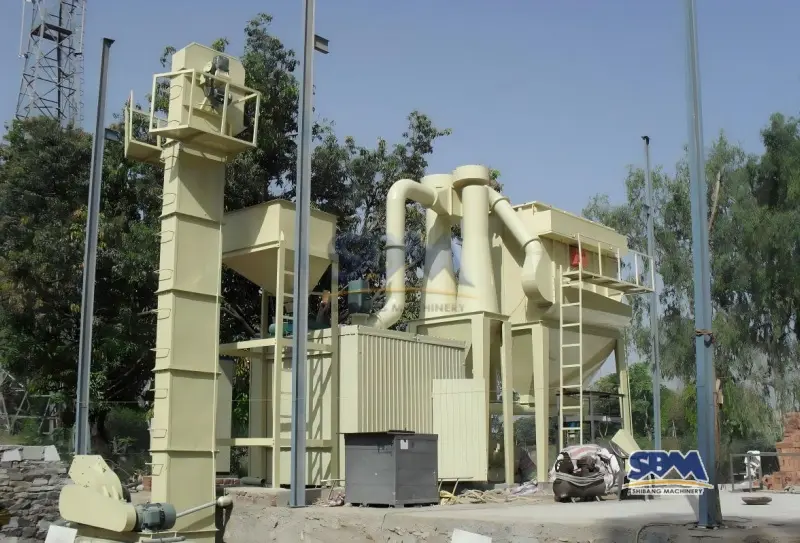
3.1 The Grinding Line: From Grit to Microns
- The Mill: Where Size Reduction Happens: Pre-crushed calcite (ideally ≤30mm, often dried first) is fed, usually via a bucket elevator, into the mill’s grinding chamber. The action inside varies wildly by mill type:
- Fábrica de bolas: Steel balls tumble and crush the material.
- Raymond Mill (o Molino vertical – VRM): Rollers press against a rotating grinding ring.
- Fábrica ultrafina: Multiple rollers or media grind against a ring or each other under high pressure. Intense forces (compression, impacto, cortar) break particles down relentlessly.
- The Gatekeeper: Clasificación: Air blows ground powder out of the mill into a sizing screen (built-in or separate). This screen is the control center. It spins fast and uses air streams to sort grains by size and weight. Tiny grains “escape” past spinning arms. Bigger grains get thrown back for more grinding. This constant sorting controls how fine the powder gets.
- Capturing the Goods: Collection: Fine powder leaving the sorter enters a spinning separator (cyclone). Aquí, fast spinning flings powder against the walls. The powder slides down and comes out the bottom as finished product. Nearly-clean air exits the top. A final giant vacuum bag (bag filter) catches any superfine dust the separator missed. This stops dust pollution and saves every bit of product. The collected powder is your ready-to-use ground calcium carbonate (GCC).
3.2 Picking Your Grinder: Microns Matter (and So Does Cost)
The mill choice dictates your product range, quality, and bottom line. There’s no universal winner.
3.2.1 Fábrica de bolas: The Traditional Tank
- Where it Shines: Proven technology. Can handle very high capacities for coarse to medium powders (pensar 35-200 malla / 500-75 micras). Rugged construction. Can theoretically grind wet or dry (though dry is common for calcite processing). Simple operating principle.
- The Reality Check: It’s a space hog and requires massive foundations. Eficiencia energética? Pobre, especially for finer grinds. A huge chunk of the energy just moves the heavy mill and charge, not breaking rock. Noise and vibration are significant issues. The particle size distribution it produces is broad – lots of both fines and coarse particles unless paired with an eficiente external classifier (adding cost/complexity). Reaching fine sizes (<325 malla) is slow and extremely energy-intensive. Lining and ball wear add cost.
- Bottom Line: Still used for high-tonnage, coarse filler production where tight particle size control isn’t critical. Think lower-end plastics fillers, lima agrícola, or coarse putty powders. Its dominance is fading due to efficiency concerns.
3.2.2 Raymond Mill / Molino vertical (VRM): The Industry Workhorse
- Where it Shines: This is the punto for standard GCC (80-325 malla / 180-45 micras). Vastly better energy efficiency than ball mills for this range. Compact footprint. The integrated dynamic classifier provides excellent control over particle top size and a narrower distribution than ball mills. Operation is relatively clean and dry. Noise levels are manageable. Modern versions offer good automation for consistent quality. Lower wear rates than ultrafine mills.
- The Reality Check: Higher upfront cost than simple hammer mills (but often competitive or better than ball mills for equivalent fine grinding). Roller and ring wear needs monitoring and impacts product quality if excessive. Feed size is limited (keep it under 30mm!). Getting significantly below 325 mesh consistently becomes difficult and inefficient. Grinding very hard impurities can be problematic.
- Bottom Line: The go-to solution for the vast majority of GCC applications: paper filling and coating, paint extenders, PVC pipes and profiles, adhesives, selladores, construction chemicals. Offers the best balance of cost, eficiencia, and quality for medium-fine powders.
3.2.3 Fábrica ultrafina (HGM, Stirred Media, etc.): The Precision Instrument
- Where it Shines: Reaching the finer realms (325-2500+ malla / 45-5 microns and below). Essential for high-performance applications where surface area, particle size distribution width, and top-cut control are critical. Can produce powders with exceptionally narrow distributions. Modern designs integrate highly efficient classifiers. This is the machine for products competing with precipitated calcium carbonate (PCC) or demanding functional fillers.
- The Reality Check: Highest capital and operating costs per ton. Complexity jumps – operation and maintenance require skilled personnel. Production capacities are lower than Raymond mills for the same investment. Extremely sensitive to feed material moisture, hardness variations, and impurities. Desgaste en elementos de molienda (rollers, media, revestimiento) is a major operating cost factor. Energy consumption per ton is high due to the intense forces needed for ultrafine grinding.
- Bottom Line: Reserved for high-value GCC markets: specialty papers (improved opacity, suavidad), high-end plastics (impact modification, surface finish), premium paints and coatings (gloss control, dispersion), functional fillers in adhesives/sealants, and niche applications like pharmaceuticals or cosmetics. You need the market price to justify the cost.
Grinding Mill Showdown: Matching Machine to Market
| Característica | Fábrica de bolas | Raymond Mill / VRM | Fábrica ultrafina | What It Means for Your Business |
|---|---|---|---|---|
| Target Fineness | Coarse Sand to Medium Filler | Standard Fine Filler | Superfine / Functional Filler | Defines your product portfolio & pricing |
| Energy Bill | Very High | Moderado (Best in Class) | Alto | Major operational expense |
| Plant Space Needed | Masivo | Compact | Compact to Medium | Site layout & foundation costs |
| Particle Consistency | Wide Spread | Good Control | Tight Control | Product performance & customer specs |
| Upfront Cost | Alto (for Structure) | Medium-High | Very High | Capital investment hurdle |
| Costos de funcionamiento | Alto (Fuerza + Medios de comunicación) | Medio (Fuerza + Piezas de desgaste) | Alto (Fuerza + Piezas de desgaste) | Ongoing profitability factor |
| Operational Headaches | Noise, Vibration, Polvo | Manageable | Complexity, Sensitivity | Staffing, skill, downtime risk |
| Market Fit | Basic Fillers, Low Cost | Papel, Paint, PVC, Construcción | Premium Papers, Revestimiento, Plástica | Where your revenue comes from |
The Calcite Processing Plant: It’s a Symphony (Mostly)
A working calcite processing plant isn’t just a bunch of machines lined up. It’s a carefully choreographed system. Conveyors snake everywhere. Dust collectors hum. Screens shake. Crushers roar. Mills grind. The air might smell faintly of rock dust and hot machinery. Seeing raw, dirty rock go in one end and clean, precisely sized aggregate, arena, or bright white powder come out the other is genuinely satisfying engineering.
Designing one? It’s a puzzle. What’s the primary product? Agregados? Arena? Coarse powder? Fine powder? A mix? What’s the feed rock like – pure white calcite marble or a harder, impure caliza? Cuantos toneladas por hora? What’s the power cost? Water availability? Environmental noise and dust limits? Presupuesto? Every answer changes the equipment selection and layout. Reliable partners for key machines (like crushers from SBM China or precision mills) are worth their weight in gold to minimize downtime headaches. The best plants run smoothly, efficiently, and produce consistent, on-spec product day in and day out. It’s harder than it looks.
Why Bother? The Calcite Imperative
So why go through all this crushing, organización, molienda, and cleaning? Because processed calcite, as calcium carbonate, is simply irreplaceable in the modern world. Its combination of properties is unmatched:
- Whiteness/Brightness: Easily whitened, providing opacity and a clean base.
- Low Hardness/Abrasion: Gentle on processing equipment (compared to alternatives) and end-use applications.
- Chemical Purity: High CaCO₃ content means predictable performance.
- Abundance: Geologically widespread, ensuring long-term supply.
- Crucialmente, Low Cost: Delivers significant functionality at a highly competitive price point.
It acts as a filler (reducing cost), an extender (improving coverage), a pigment (adding whiteness), a rheology modifier (controlling flow), and even a reinforcement agent. Mirar alrededor:
- Construcción: Concreto, asfalto, drywall, joint compounds, selladores, roofing materials.
- Papel: Filler inside the sheet (bulk, opacidad) and coating on the surface (suavidad, printability).
- Plástica: Pipes, profiles, films, containers – improves stiffness, impact strength, surface finish, and reduces cost.
- Pintura & Revestimiento: Extender pigment, Mejora la durabilidad, sheen control, and scrub resistance.
- Adhesives & Sealants: Vara, rheology control, cost reduction.
- Even Beyond: Agricultura ( soils), pharmaceuticals (inactive filler), food (additive), ambiental (flue gas desulfurization).
The demand driven by global construction, infrastructure development, packaging, and manufacturing is relentless. Eficiente, intelligent calcite processing isn’t just about making rock smaller; it’s about unlocking a fundamental resource that quietly underpins so much of our daily lives and industrial output. It’s a fascinating, básico, and constantly evolving field.
Oficina central
Whatsapp:+8615225176731
Correo electrónico: [email protected]
DIRECCIÓN: No. 1688, Camino del este de Gaoke, Nuevo distrito de Pudong, Llevar a la fuerza, Porcelana.
Sitio web: https://www.mill-sbm.com/

